The economy of Ilocos Region grew by 6.5 percent in 2018, faster than the 5.8 percent growth in the previous year. The region’s Gross Domestic Product (GDP) is valued at 289.9 billion pesos, at constant 2000 prices, in 2018. This was 17.8 billion pesos higher than its estimated value of 272.1 billion pesos in 2017. In 2016, it was recorded at 257.3 billion pesos while in 2015 at 237.2 billion pesos.
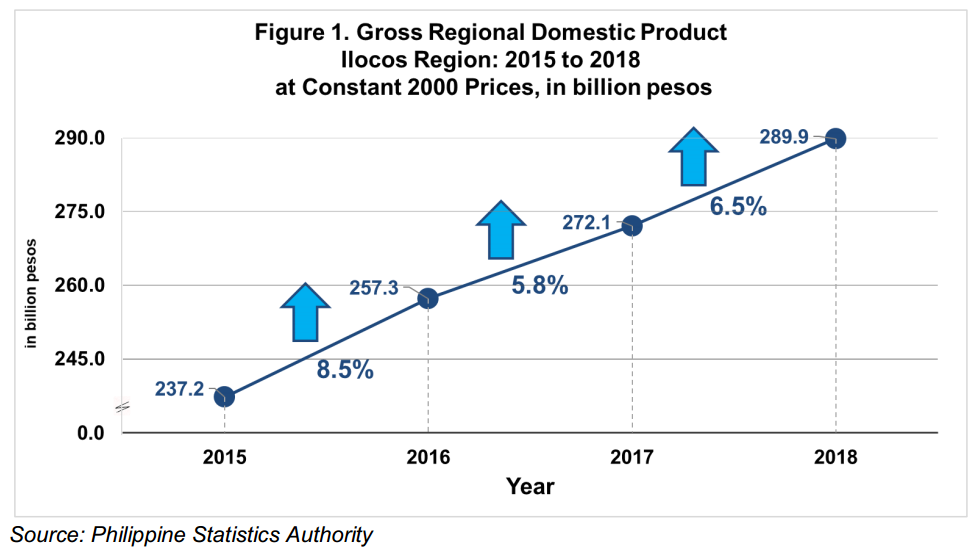
Figure 2 shows that in the past four years, the economy of Ilocos Region grew the fastest in 2016 at 8.5 percent. The economic performance of the region grew the slowest in 2015 at 5.4 percent. The region’s economic growth of 6.5 percent in 2018 was the second highest in the past four years.
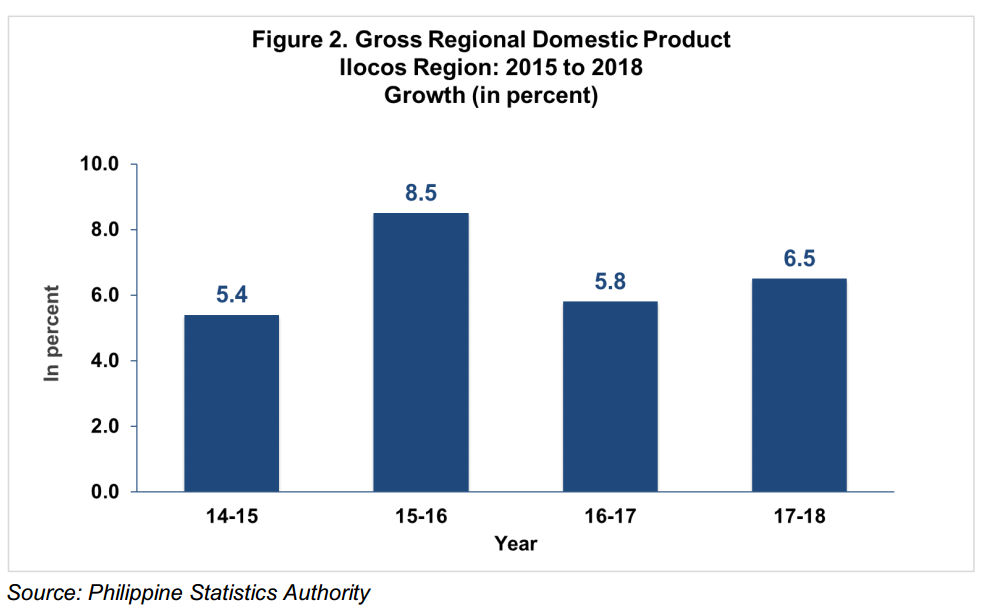
As manifested in Table 1, the performance of the national economy decelerated by 6.2 percent in 2018 from 6.7 percent in 2017. On the other hand, Ilocos Region’s economy accelerated by 6.5 percent in 2018 from 5.8 percent in 2017, faster than the national economic growth.
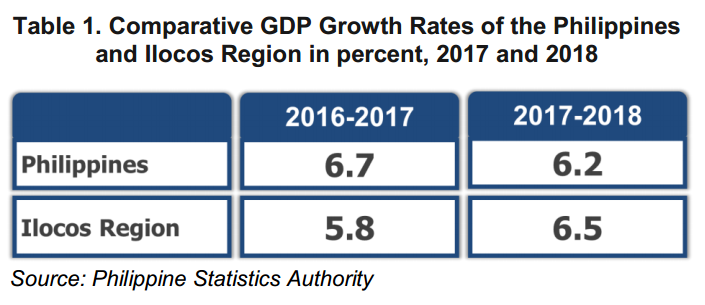
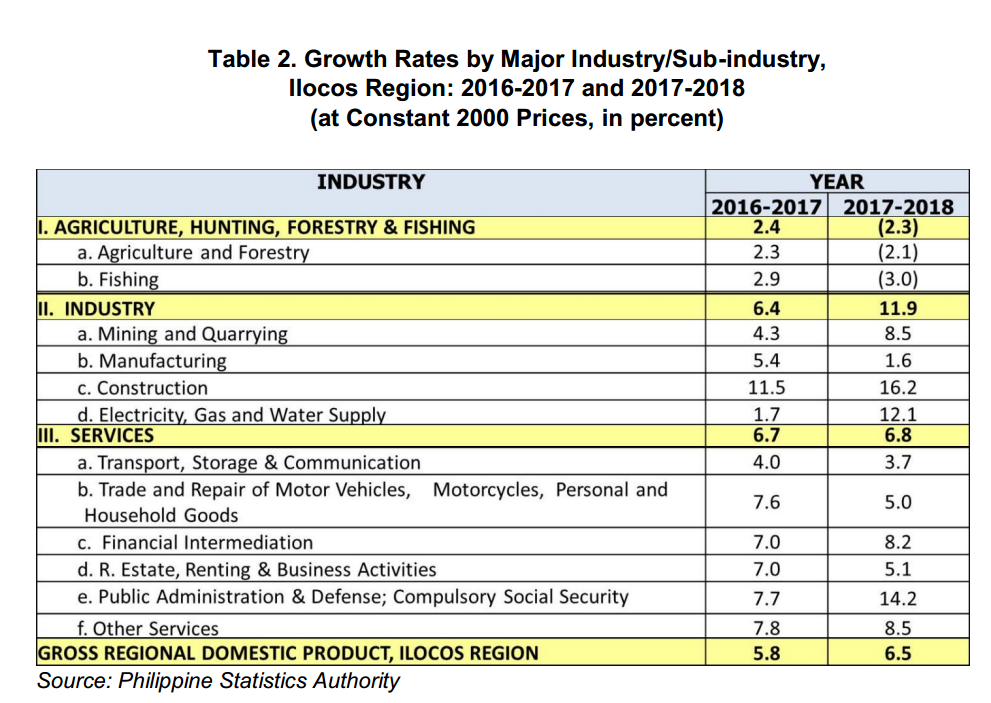
In terms of growth rates, by major industries and sub-industries in 2017 and 2018, Industry had the fastest growth among the major industries, with 11.9 percent in 2018, compared with the previous year’s figure of 6.4 percent.
Services grew slightly faster by 6.8 percent in 2018 compared with the previous year’s growth of 6.7 percent. Meanwhile, Agriculture, Hunting, Forestry and Fishing (AHFF) recorded a 2.3 percent decline in 2018, a downturn from its 2.4 percent growth in 2017.
For Industry, Construction remained as the biggest contributor to growth with 16.2 percent increase compared with the 11.5 percent growth in 2017. It was followed by Electricity, Gas and Water Supply (EGWS), which grew by 12.1 percent; and Mining and Quarrying with 8.5 percent. Manufacturing, on the other hand, grew at a slower rate of 1.6 percent compared with the 5.4 percent growth in the previous year.
Among the sub-industries of Services, Public Administration and Defense; Compulsory Social Security grew the fastest with 14.2 percent. It was followed by Other Services with 8.5 percent and Financial Intermediation with 8.2 percent. On the other hand, the following sub-industries also grew, but at a slower pace: Transportation, Storage and Communication, 3.7 percent; Trade and Repair of Motor Vehicles, Motorcycles, Personal and Household Goods, 5.0 percent; and Real Estate, Renting and Business Activities (RERBA), 5.1 percent.
For the AHFF sub-industries, Agriculture and Forestry as well as Fishing both contracted, by 2.1 percent and 3.0 percent, respectively.
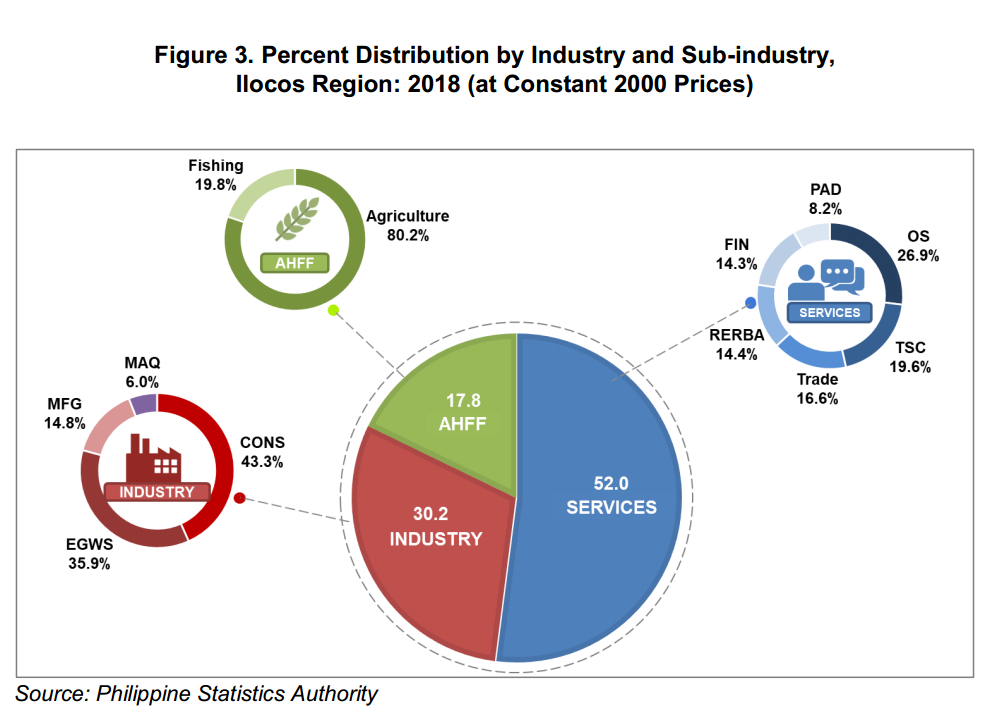
The economy of Ilocos region is predominantly Services-based, accounting for 52.0 percent of the region’s total output. Other Services which include Education, Health and Social Welfare, Hotel and Restaurants and Recreation Activities accounted for the largest share in Services with 26.9 percent. This was followed by Transport, Storage and Communication with 19.6 percent share; Trade and Repair of Motor Vehicles, Motorcycles, Personal and Household Goods with 16.6 percent share; Real Estate, Renting and Business Activities with 14.4 percent share; Financial Intermediation with 14.3 percent share; and Public Administration and Defense with the smallest share of 8.2 percent.
The share of Industry contributed 30.2 percent to the region’s total economy. Among its sub-industries, Construction accounted for the biggest share with 43.3 percent. Electricity, Gas, and Water Supply followed with 35.9 percent share while Manufacturing accounted for 14.8 percent. Meanwhile, Mining and Quarrying had the least share of 6.0 percent.
AHFF remained to be the least contributor to the region’s economy with 17.8 percent share. Its sub-industries, Agriculture and Fishing accounted for 80.2 percent and 19.8 percent respectively of the AHFF output.
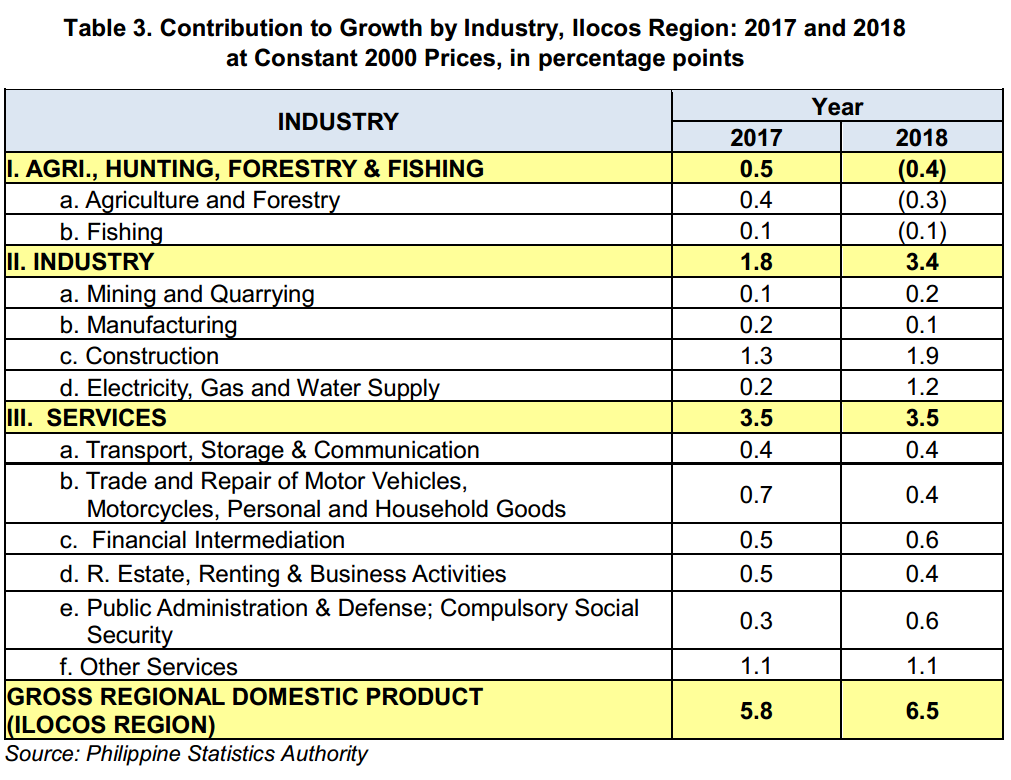
It can be gleaned in Table 3 the contribution of the major industries to the over-all economic growth of the region in 2018. Services contributed the highest with 3.5 percentage points closely followed by Industry with 3.4 percentage points. On the other hand, AHFF pulled down the region’s economic performance by 0.4 percentage point.
Among the industries, Construction contributed the highest with 1.9 percentage points, followed by EGWS with 1.2 percentage points and Other Services with 1.1 percentage points.

Among the sub-industries of Other Services, Education had the highest contribution to growth with 7.1 percentage points. This was followed by Health and Social Work and Hotel and Restaurants both contributing 0.7 percentage point each. Other Service Activities like sewage, recreation, etc, contributed almost negligible to the industry with 0.0 percentage point.
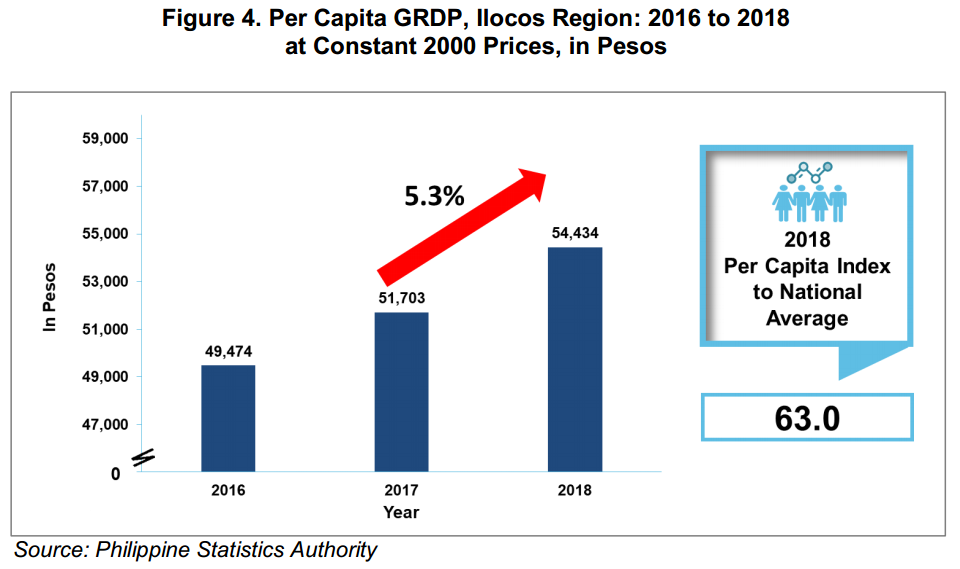
The per capita GRDP of Ilocos Region was estimated at 54,434 pesos, which grew by 5.3 percent from the previous year’s record. Per capita GRDP is the total GRDP level of the region divided by its total population to see how much each individual contributes to the regional economy. The 2018 per capita index of Ilocos Region to the national average is 63.0 percent.
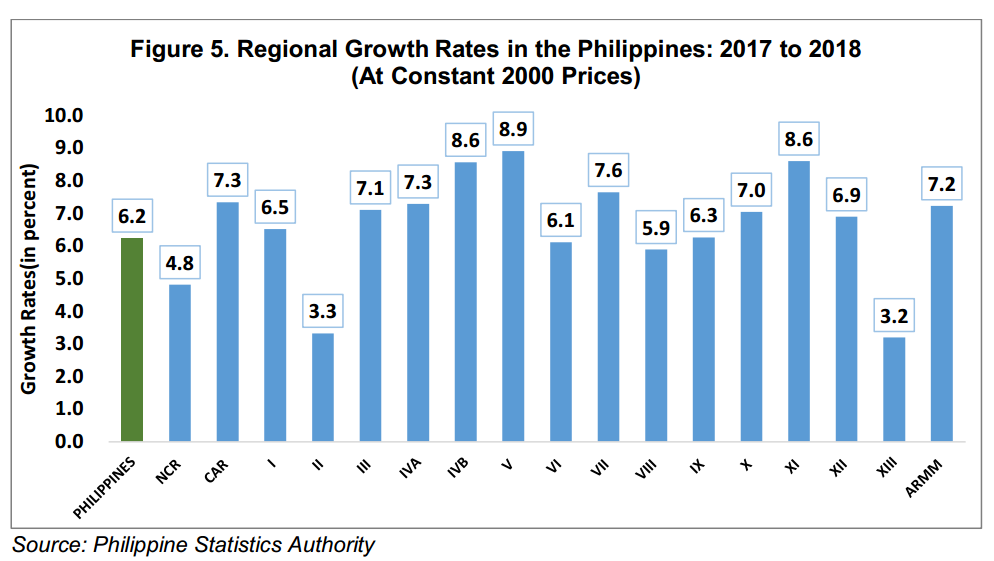
Among the 17 regions, 12 regions including Ilocos Region, posted higher growth rates than the national GDP growth of 6.2 percent. Moreover, Ilocos Region was also one of the 8 regions that posted accelerated growths in 2018. The region ranked 11th highest in 2018 in terms of growth rate, maintaining its rank in the previous year.
Bicol Region grew the fastest at 8.9 percent, followed by MIMAROPA and Davao Region each growing by 8.6 percent.
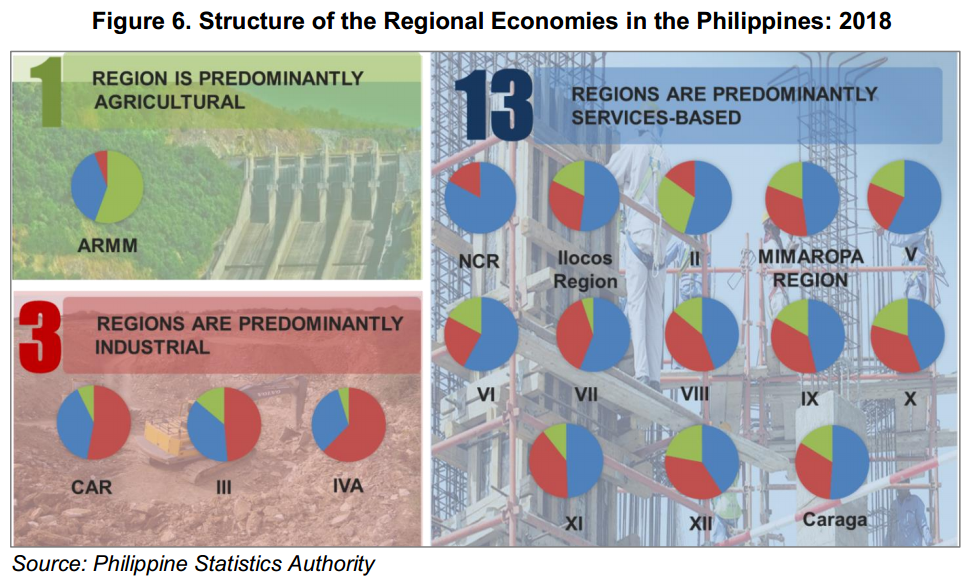
In terms of the economic structure, Ilocos Region is one of the 13 regions whose economy is predominantly Services-based in 2018.
Three regions, namely the Cordillera Administrative Region (CAR), Central Luzon, and CALABARZON are predominantly industrial while the Autonomous Region in Muslim Mindanao (ARMM) remained predominantly agricultural.
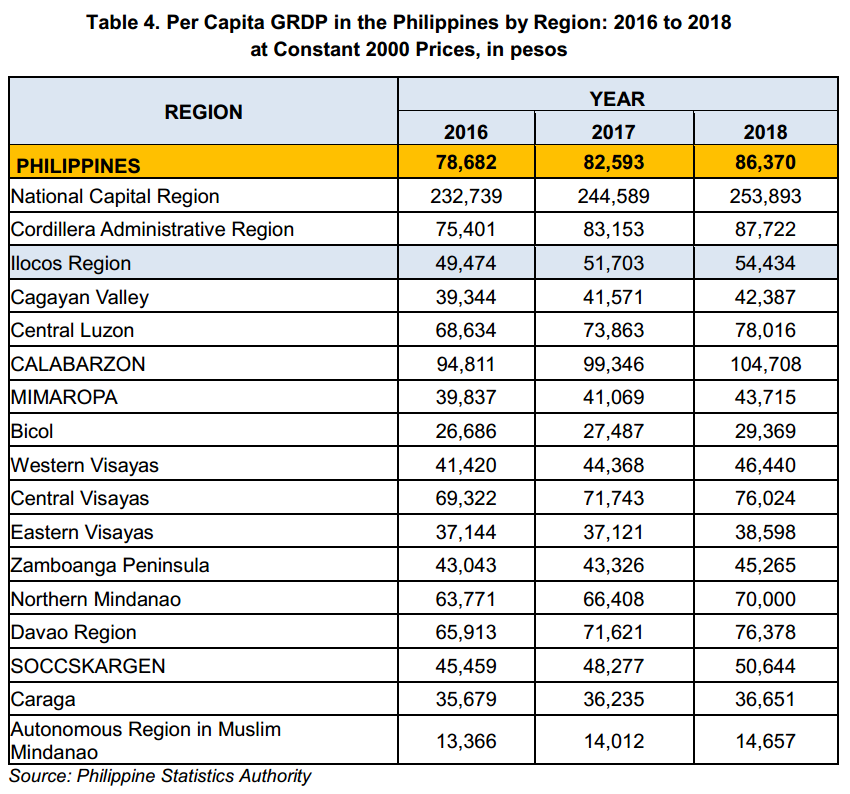
As shown in Table 4, the per capita GRDP of Ilocos Region was registered at 54,434 pesos, lower than the national per capita GDP of 86,370 pesos.
Ilocos Region ranked 8th in terms of per capita GRDP among all regions. National Capital Region (NCR) ranked first.
TECHNICAL NOTES
Gross Regional Domestic Product (GRDP) is the aggregate of gross value added (GVA) of all resident producer units in the region.
The GRDP includes regional estimates on the three major industries including their sub-industries namely:
- Agriculture, Hunting, Forestry and Fishing (AHFF)
- Industry Sector
- Mining and Quarrying
- Manufacturing
- Construction
- Electricity, Gas and Water Supply (EGWS)
- Service Sector
- Transport, Storage and Communication (TSC)
- Trade and Repair of Motor Vehicles, Motorcycles, Personal and Household Goods
- Financial Intermediation (FI)
- Real Estate, Renting and Business Activity (RERBA)
- Public Administration and Defense; Compulsory Social Security (PAD)
- Other Services (OS)

